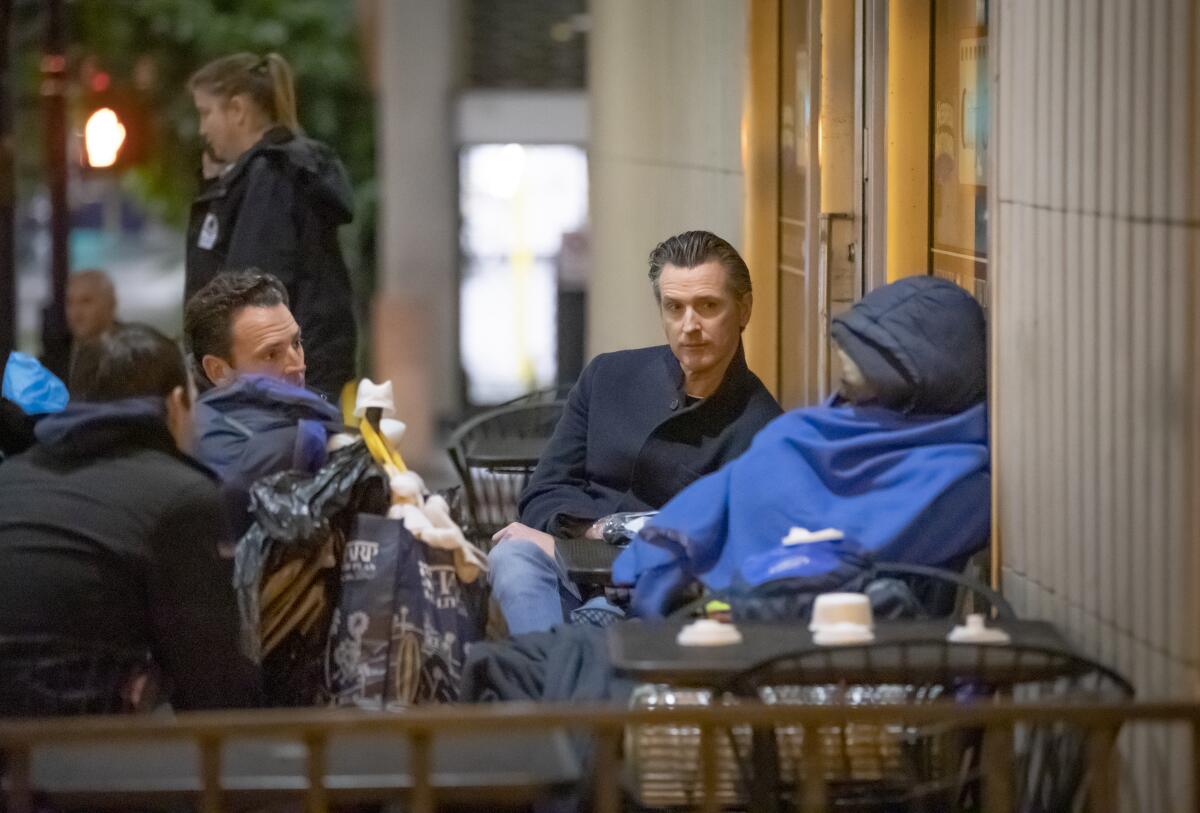News Analysis: Newsom’s focus on homelessness puts the spotlight on his next move. But what’ll it be?

Before Gov. Gavin Newsom took office, it had been three decades since a governor last said the word “homeless” during an annual State of the State address.
Newsom said it seven times in his 2019 speech — six times more than then-Gov. George Deukmejian did in 1990, the only other instance found in readily available records of past chief executives.
In his second State of the State on Wednesday, Newsom went all in.
“The state of California can no longer treat homelessness and housing insecurity as someone else’s problem, buried below other priorities that are much easier to win or better-suited for soundbites,” Newsom told a joint session of the Legislature.
“It is our responsibility. And it must be at the top of our agenda.”
For the better part of 42 minutes, the governor soberly assessed how California stumbled, chronicling the unfulfilled promises and political indifference that he said has lasted for decades.
It was equal parts history lesson and policy analysis, at times sounding like a Sunday sermon.
“We turned away when it wasn’t our sister, our brother, our neighbor, our friend. And when it was a loved one, help wasn’t there,” Newsom said. “Most of us experienced homelessness as a pang of guilt, not a call to action.”
Liberals and conservatives in the Legislature alike gave the governor high marks for singling out the issue and said they are ready to roll up their sleeves.
“We feel the rhythm. We feel the urgency. We feel the need every single day,” Senate President Pro Tem Toni Atkins (D-San Diego) said. “Now we need to figure out the details and what we’re going to do.”
“It’s time to bring all levels of government together to address the most pressing issue facing our state,” Assembly Republican Leader Marie Waldron (R-Escondido) said.
But it’s in deciding what comes next — what blend of dollars and directives are needed — where deep divisions remain. Some insist California needs a legal mechanism to force communities to provide shelter. Others say government officials need to tackle the underlying causes of homelessness, including a lack of long-term affordable housing and robust health and human services.
During Wednesday’s speech, the governor suggested that no idea should be dismissed out of hand.
“Healthcare and housing can no longer be divorced,” he said. Then he offered this idea: “Doctors should be able to write prescriptions for housing the same way they do for insulin or antibiotics. Why not?”
The insistence that no topic be off-limits at the negotiating table may reflect public sentiment. In a statewide poll released last week by USC, 64% of those surveyed said there should be restrictions on sleeping in tents in public places. But only 28% supported strict enforcement of living on the streets without also providing shelter. Perhaps just as troubling: More than one-third of respondents feared they too could become homeless.
Other polls show the issue is by far the top concern of California voters — even after some $1.1 billion in state spending to address the problem over the past two years. An additional $2 billion in bonds will be spent on housing for homeless men and women with mental health needs. And Newsom proposed another $1.4 billion, much of that as cash spent on local services, in his recent budget plan.
Criticism of the state’s response to the crisis is leveled daily — and hourly in some cases through social media and by President Trump. The most recent data, compiled by state and federal officials during the governor’s first year in office, found that California is home to 27% of the nation’s homeless population.
Perhaps no elected official is as vulnerable to political fallout from the crisis as Newsom.
Long on exhortations for action, his State of the State speech was largely devoid of any hint of which path he would choose. It was sometimes unclear if the governor was calling for new get-tough actions or would simply rely on those already in place. For example, Newsom chastised county-level officials for hoarding unspent cash from a 2004 ballot measure designed to boost mental health services.
“My message is this. Spend your mental health dollars by June 30, or we’ll make sure they get spent for you,” he said.
But a 2018 law governing these unspent dollars already requires counties to have a plan by that date. In which case, answering Newsom’s ultimatum may simply be as easy as following the statute already on the books.
And that’s to say nothing of the difficulties that remain in rethinking the state’s policy on affordable housing. With a landmark effort to boost housing density resoundingly rejected by the state Senate last month, all eyes are on Newsom to weigh in on the balance between local control and statewide priorities.
Newsom, who served two terms as mayor of San Francisco, sounded a note of frustration on the issue during Wednesday’s address.
“Look, I respect local control,” he told lawmakers. “But not at the cost of creating a two-California class system. Not at the cost of imperiling the California Dream. And that’s what we’re doing.”
As a political candidate, Newsom painted in broad strokes and called for aggressive action. In governing, his early approach has been more incremental. Governors hold sway over many things, but legislators and key interest groups must be a part of any solution.
Whether one style or the other will serve the current environment better remains to be seen. But the clock is ticking.
Hours after Newsom’s speech ended, the crisis remained painfully obvious outside the Capitol. On the streets leading to the gleaming 19th-century building, men and women huddled. Some slept, others pleaded, a few screamed at everyone and no one. They have become a living, and too often dying, symbol of a California crisis — one that could define Newsom’s legacy.







